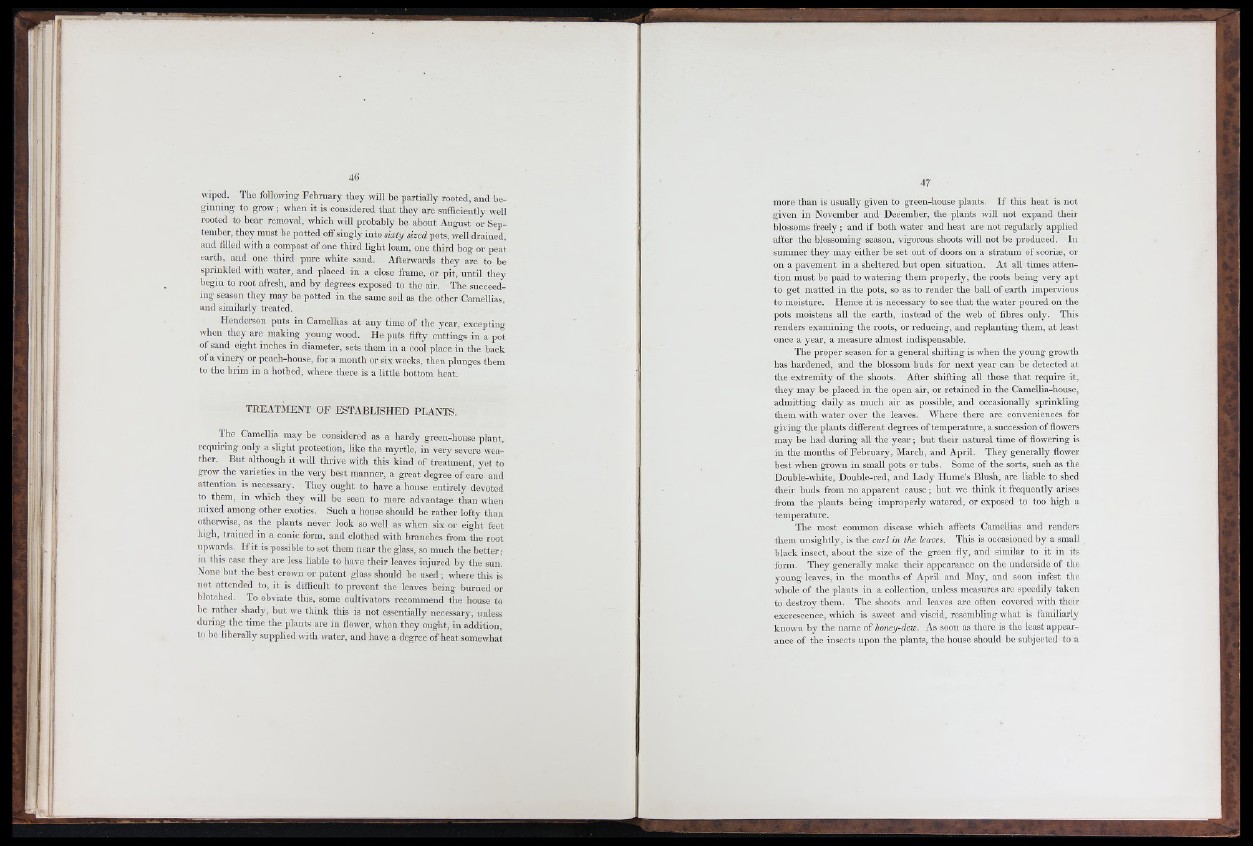
wiped. Tlie following- February they will be p artially rooted, and beginning
to g row ; when it is considered th a t th ey are sufficiently well
rooted to bear removal, which will probably be about August or September,
th ey m ust be potted off singly into sixty sized pots, well drained,
and filled with a compost of one th ird light loam, one th ird bog or peat
earth, and one th ird pure white sand. Afterwards they are to be
sprinkled with water, and placed in a close frame, or p it, u n til they
begin to root afresh, and b y degrees exposed to the air. The succeeding
season they may be potted in the same soil as the other Camellias,
and similarly treated.
Henderson puts in Camellias a t any time o f th e year, excepting-
when they are making young wood. He puts fifty cuttings in a pot
o f sand eight inches in diameter, sets them in a cool place in the back
of avm e ry or peach-house, for a month or six weeks, then plunges them
to the b rim in a hotbed, where there is a little bottom heat.
TREATMENT OF ESTABLISHED PLANTS.
The Camellia may be considered as a hardy green-house plant,
requiring only a slight protection, like the myrtle, in very severe weal
ther. Bu t although it will thrive with this k ind of treatment, y e t to
grow the varieties in th e very best manner, a great degree o f care and
attention is necessary. They ought to have a house entirely devoted
to them, in which th ey will be seen to more advantage th an when
mixed among other exotics. Such a house should be rather lofty than
otherwise, as the plants never look so well as when six or eight feet
high, trained in a conic form, and clothed with branches from the root
upwards. I f it is possible to set them near the glass, SO much the better;
111 this case th ey are less liable to have the ir leaves injured by th e sun'.
None b u t the best crown or p aten t glass should be u sed ; where this is
not attended to, it is difficult to prevent the leaves being burned or
blotched. To obviate this, some cultivators recommend th e house to
be rath er shady, b u t we th in k this is not essentially necessary, unless
during th e time the plants are in flower, when they ought, in addition,
to be liberally supplied with water, and have a degree o f heat somewhat
47
more th an is usually given to green-house plants. I f this heat is not
given in November and December, th e plants will not expand their
blossoms freely ; and if both water and heat are not regularly applied
after the blossoming season, vigorous shoots will not be produced. In
summer th ey may either be set out of doors on a stratum of scoriæ, or
on a pavement in a sheltered b u t open situation. A t all times attention
must be paid to watering them properly, th e roots being very apt
to get matted in th e pots, so as to render the ball of earth impervious
to moisture. Hence i t is necessary to see th a t the water poured on the
pots moistens all th e earth, instead o f the web of fibres only. This
renders examining the roots, or reducing, and replanting them, a t least
once a year, a measure almost indispensable.
The proper season for a general shifting is when the young growth
has hardened, and the blossom buds for n ex t year can be detected at
the extremity of th e shoots. After shifting all those th a t require it,
th ey may be placed in the open air, or retained in the Camellia-house,
admitting daily as much air as possible, and occasionally sprinkling
them with water over the leaves. Where there are conveniences for
giving the plants different degrees of temperature, a succession of flowers
may be had during all the year ; b u t the ir natural time o f flowering is
in th e months of F ebma ry, March, and April. They generally flower
best when grown in small pots or tubs. Some of the sorts, such as the
Double-white, Double-red, and Lady Hume’s Blush, are liable to shed
their buds from no apparent cause ; b u t we th in k it frequently arises
from the plants being improperly watered, or exposed to too high a
temperature.
The most common disease which affects Camellias and renders
them unsightly, is the curl in the leaves. This is occasioned by a small
black insect, about the size of the green fly, and similar to it in its
ibrm. They generally make th e ir appearance on the underside o f the
young leaves, in the months of April and May, and soon infest tlie
w'hole of the plants in a collection, unless measures are speedily taken
to destroy them. The shoots and leaves are often covered with their
excrescence, which is sweet and viscid, resembling what is familiarly
known b y the name of honey-dew. As soon as there is the least appearance
of the insects upon the plants, the house should he subjected to a